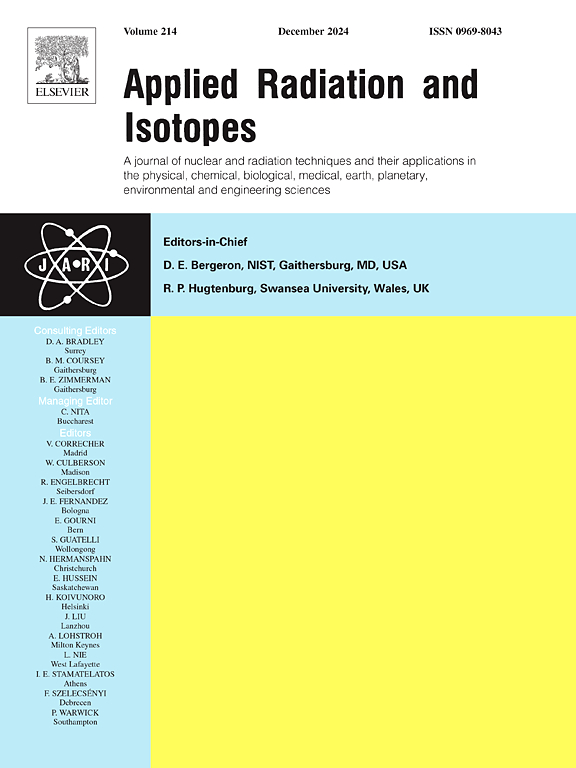测量 68Zn、96Zr、121Sb 和 123Sb 在 1 至 2 MeV 能量范围内的快中子诱导 (n,γ) 反应截面。
IF 1.6
3区 工程技术
Q3 CHEMISTRY, INORGANIC & NUCLEAR
引用次数: 0
摘要
反应堆结构/屏蔽材料中存在的 68Zn、96Zr、121Sb 和 123Sb 等元素的(n,γ)反应截面是通过中子活化技术在 1-2 兆电子伏的中子能量区测量的,因为在这一能量范围内可获得的数据非常有限。此外,快中子增殖反应堆和拟议的加速器驱动亚临界系统的中子能谱在这一能量区域达到峰值。考虑到 86Sr(n,γ)87Srm 和 87Sr(n,n')87Srm 反应的有效组合反应截面,天然锶(natSr)元素被用作中子通量监测器。在印度孟买的巴哈原子研究中心 FOTIA,样品和监测器的混合物颗粒受到由 7Li(p,n)7Be 反应产生的准单能快中子束的辐照。活化产物的活度是通过使用高纯锗探测器(HPGe)的离线伽马射线光谱仪测量的。本数据改进了不确定性和协方差分析,增强了横截面数据基础,从而更好地约束了评估数据和理论模型。理论(n,γ)反应截面是用 TALYS 1.96 计算的,它可以合理地解释费米气体水平密度处方的现有数据。本文章由计算机程序翻译,如有差异,请以英文原文为准。
Measurement of fast neutron induced (n,γ) reaction cross-section of 68Zn, 96Zr, 121Sb and 123Sb in the energy range of 1 to 2 MeV
The (n,γ) reaction cross-section for the elements 68Zn, 96Zr, 121Sb and 123Sb, present in the reactor structural/shielding materials, was measured by neutron activation technique in the neutron energy region of 1–2 MeV as very limited data is available in this energy range. Further, the neutron spectrum peaks in this energy region for the fast breeder reactors and proposed accelerator driven sub-critical systems. The natural strontium (natSr) element was used as a neutron flux monitor by considering effective combined reaction cross-section for 86Sr(n,γ)87Srm and 87Sr(n,n′)87Srm reactions. The pellets of mixture of sample and monitor were irradiated by a quasi-mono energetic fast neutron beam, generated by 7Li(p,n)7Be reaction at FOTIA, Bhabha Atomic Research Centre, Mumbai, India. The activity of activation products was measured by off-line gamma-ray spectrometry using High Purity Germanium Detector (HPGe). The present data with improved uncertainty and covariance analysis enhance the cross-section data base for better constraining the evaluated data and theoretical models. The theoretical (n,γ) reaction cross-sections were calculated using TALYS 1.96, which could reasonably explain the present data with the Fermi gas level density prescription.
求助全文
通过发布文献求助,成功后即可免费获取论文全文。
去求助
来源期刊

Applied Radiation and Isotopes
工程技术-核科学技术
CiteScore
3.00
自引率
12.50%
发文量
406
审稿时长
13.5 months
期刊介绍:
Applied Radiation and Isotopes provides a high quality medium for the publication of substantial, original and scientific and technological papers on the development and peaceful application of nuclear, radiation and radionuclide techniques in chemistry, physics, biochemistry, biology, medicine, security, engineering and in the earth, planetary and environmental sciences, all including dosimetry. Nuclear techniques are defined in the broadest sense and both experimental and theoretical papers are welcome. They include the development and use of α- and β-particles, X-rays and γ-rays, neutrons and other nuclear particles and radiations from all sources, including radionuclides, synchrotron sources, cyclotrons and reactors and from the natural environment.
The journal aims to publish papers with significance to an international audience, containing substantial novelty and scientific impact. The Editors reserve the rights to reject, with or without external review, papers that do not meet these criteria.
Papers dealing with radiation processing, i.e., where radiation is used to bring about a biological, chemical or physical change in a material, should be directed to our sister journal Radiation Physics and Chemistry.
 求助内容:
求助内容: 应助结果提醒方式:
应助结果提醒方式:


